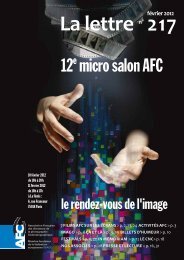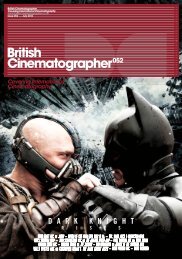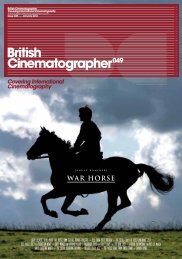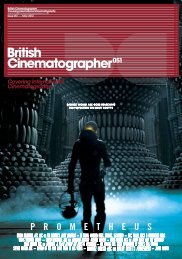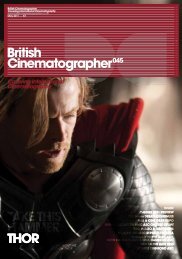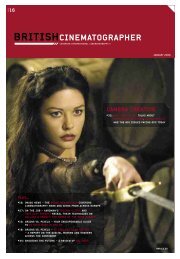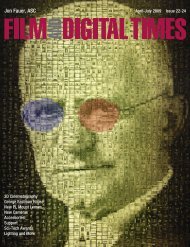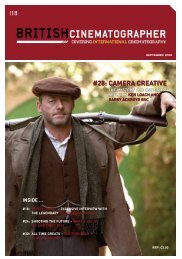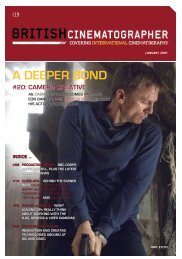Create successful ePaper yourself
Turn your PDF publications into a flip-book with our unique Google optimized e-Paper software.
The first Whole Earth Catalog came out in 1968. Like this issue of<br />
<strong>Film</strong> and <strong>Digital</strong> <strong>Times</strong>, it didn’t sell anything. It was a resource,<br />
like an early Google: tools and where to find them.<br />
Stewart Brand, the editor, wrote in his introduction, “The Whole<br />
Earth Catalog functions as an evaluation and access device. With<br />
it, the user should know better what is worth getting and where<br />
and how to do the getting.” About the NASA images on the cover,<br />
“They gave the sense that Earth’s an island, surrounded by a lot<br />
of inhospitable space.” Not coincidentally, the first Earth Day was<br />
celebrated in 1970. It was a pivotal moment. People suddenly realized<br />
that our planet was a fragile place, handle with care.<br />
Fast forward to 2007. Japan’s Aerospace Exploration Agency<br />
launched Kaguya (SELENE), a lunar orbiter that included an HD<br />
video camera developed by NHK. At IBC 2010, one of the hits of<br />
the show was NHK’s new 8K video camera and the spectacularly<br />
life-like images it could produce.<br />
Which brings us to December 2010 and this Whole <strong>Film</strong> and<br />
<strong>Digital</strong> <strong>Times</strong> Catalog of Cool Tools. Our cover says “Converging<br />
Worlds.” Although convergence and 3D certainly has everyone’s<br />
attention, this is the historic year of convergence and collision<br />
between consumer and professional equipment. New cameras<br />
for high-end production were previously introduced at a leisurely<br />
pace of one or two a decade. Now, an annual outing to NAB or<br />
IBC is no longer sufficient; equipment is introduced at a startling<br />
rate with each season, and our pages swell.<br />
This December 2010 issue is a window on where we are in the<br />
technique and technology of motion picture production. Soon,<br />
more people may be “capturing” than viewing images.<br />
The Whole Earth still looks like a fragile place. As Thomas Friedman<br />
recently wrote, 2010 was Earth’s hottest year on record. 98<br />
out of 100 scientists will tell us that our continued carbon emissions<br />
pose enormous risk. 2 out 100 scientists say it doesn’t. A<br />
betting person would bet on the 98 who worry about climate<br />
change. Are we feeling lucky?<br />
Where do we go from here? In 2011, I think we’ll see the unleashing<br />
of 4K. Anamorphic wide screen will lure us back into theaters.<br />
PL mounted lenses will continue to be the standard for high-end<br />
productions. <strong>Film</strong> will continue to be the standard against which<br />
everything else is compared in 2011. Happy Holidays and may all<br />
your images be beautiful in the New Year.<br />
4 Dec 2010<br />
Left: The Whole Earth Catalog<br />
was published by Stewart<br />
Brand between 1968 and<br />
1972, and sporadically until<br />
1998.<br />
Right: The Astronomer.<br />
Johannes Vermeer. 1668.<br />
Oil on canvas<br />
51.5 × 45.5 cm<br />
(20.28 × 17.91 in.)<br />
Musée du Louvre,<br />
Richelieu, 2nd floor, room <strong>38</strong><br />
Three hundred years before Earth became a brand name on<br />
Brand’s Whole Earth covers, Johannes Vermeer focused our<br />
single-source attention on The Astronomer, with perspective lines<br />
conveniently converging on his celestial globe. It was an excellent<br />
year for astronomy. Isaac Newton completed the first successful<br />
reflecting telescope (using mirrors instead of lenses). In 1668,<br />
astronomy was an excellent profession; celestial navigation was<br />
essential to the Netherland’s thriving economy based on global<br />
trade. Which is why the Astronomer’s green robe is significant.<br />
Christiane Hertel explains, in Seven Vermeers, the Japonsche<br />
Rok was a kimono tailored into a kind of house robe. The<br />
kimonos were given to Dutch merchants on their annual visit<br />
to the Imperial court in Edo (Tokyo), the only time they were<br />
permitted on the Japanese mainland. The remainder of the year,<br />
the merchants were required to live on the island of Deshima. The<br />
Dutch empire was at its height, with spices, silks, teak, coffee, and<br />
tea being shipped from its colonies around the world.<br />
Remember Shogun? The year is 1600. John Blackthorne, English<br />
navigator on a Dutch trading ship, is shipwrecked on the coast<br />
of Japan. He becomes an ally of Toranaga, falls in love with his<br />
interpreter, and is assimilated into Japanese culture.<br />
Banjin, by Andrew Laszlo, ASC (the distinguished cinematographer<br />
and author) continues a couple of centuries later, 1843. Another<br />
shipwreck. A Japanese boy, Masahiro, is rescued by American<br />
whalers and brought to New Bedford, Massachusetts. The<br />
boy is well educated at Exeter, advises Congress, goes back to sea,<br />
joins the Gold Rush in California, and returns home to Japan. He<br />
becomes a political advisor, and helps open Japan to the west as a<br />
leading character in the Meiji Restoration.<br />
Our worlds continue to shrink, along with the size of our cameras,<br />
while their sensors become larger, the number of users multiplies,<br />
as, hopefully, does the appreciation of gorgeous Vermeer lighting.



